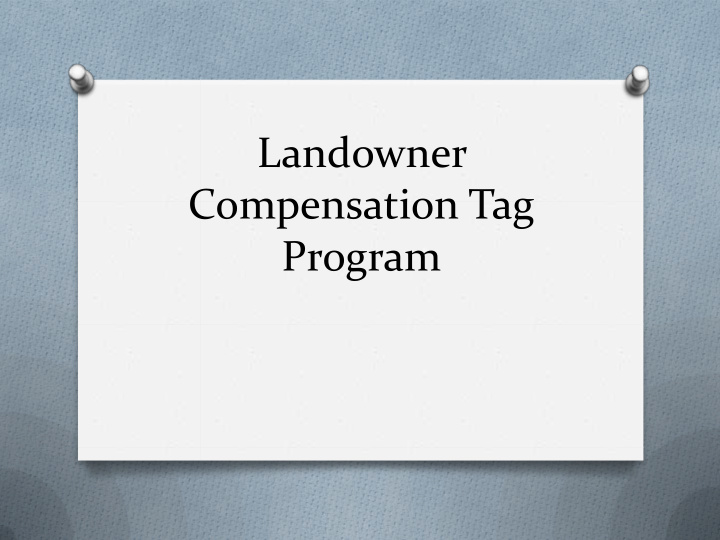



Landowner Compensation Tag Program
Issue O When annual counts are conducted to determine the number of tags a cooperator may qualify for, that number can exceed that total allowed in statute. O Was 1.5% prior to statutory change in 2017 legislative session, now 2.5% of total deer and antelope tags authorized by Commission.
January Meeting O The Commission direction: O Seek additional feedback on the concept of protecting the cooperators that receive a single damage compensation tag O Use a mathematical formula based on counts to determine how to equitably distribute any remaining tags O Favor a concept that would provide preference to cooperators that had been engaged in this program for the longest time
Since January O Sent letter to 105 participants (Commission and CABMWs). O Shared with: O Nevada Farm Bureau O Cattleman’s Association O Backcountry Hunters and Anglers O Carson Valley Chukar Club O Fraternity of the Desert Bighorn O Nevada Bighorns Unlimited (Fallon, Reno, and Midas O Nevada Bowhunters Association O Nevada Chukar Foundation O Nevada Muleys O Nevada Outfitters and Guides Association
Background on Process O Cooperator registers O Agreed upon count date O May be rescheduled O Count occurs O At low numbers, exact count generally recorded O Exact count is not always provided (qualify for 1 tag for every 50) O Exact count comes with increased time and human resource cost
Challenge O No existing regulation if statutory limit is reached: O Existing NRS has provision allowing Commission to promulgate addition NAC for program O No change to NRS needed O Existing process simple, supported O Limit increased (equivalent to about 200 tags in 2018)
Discussion Draft O 3. Damage compensation tags cannot be issued in excess of the limit established pursuant to subsection 6 (a) of NRS 502.145. If the cumulative number of damage compensation tags for which all applicants qualified through counts in a single year exceeds the limit established pursuant to subsection 6 (a) of NRS 502.145, the Department will proportionally reduce all damage compensation tag awards until the total is less than the statutory limit. If this proportional reduction results in the issuance of less than all damage compensation tags that could be issued, the remaining damage compensation tags will be issued in increments of one to cooperators with the longest continuous history of cooperative agreements with the Department until all tags are issued
Example O If limit is 200 O 50 – 1 = 50 O 30 – 2 = 60 O 10 – 3 = 30 Total = 222 O 5 – 4 = 20 O 4 – 5 = 20 O 2 – 6 = 12 O 2 – 7 = 14 O 2 – 8 = 16
Example O If limit is 200 O 50 – 1 = 50 O 30 – 2 = 60 O 10 – 2 = 30 Total = 195 O 5 – 3 = 20 O 4 – 4 = 20 80% reduction O 2 – 5 = 12 O 2 – 6 = 14 Remaining 5 awarded based O 2 – 6 = 16 on longevity in program
Example O If limit is 200 O 50 – 1 = 50 O 30 – 2 = 60 O 10 – 2 = 30* Total = 195 O 5 – 3 = 20* O 4 – 4 = 20* 80% reduction O 2 – 5 = 12* O 2 – 6 = 14 Remaining 5 awarded based O 2 – 6 = 16* on longevity in program
Questions – Discussion O 3. Damage compensation tags cannot be issued in excess of the limit established pursuant to subsection 6 (a) of NRS 502.145. If the cumulative number of damage compensation tags for which all applicants qualified through counts in a single year exceeds the limit established pursuant to subsection 6 (a) of NRS 502.145, the Department will proportionally reduce all damage compensation tag awards until the total is less than the statutory limit. If this proportional reduction results in the issuance of less than all damage compensation tags that could be issued, the remaining damage compensation tags will be issued in increments of one to cooperators with the longest continuous history of cooperative agreements with the Department until all tags are issued
Recommend
More recommend